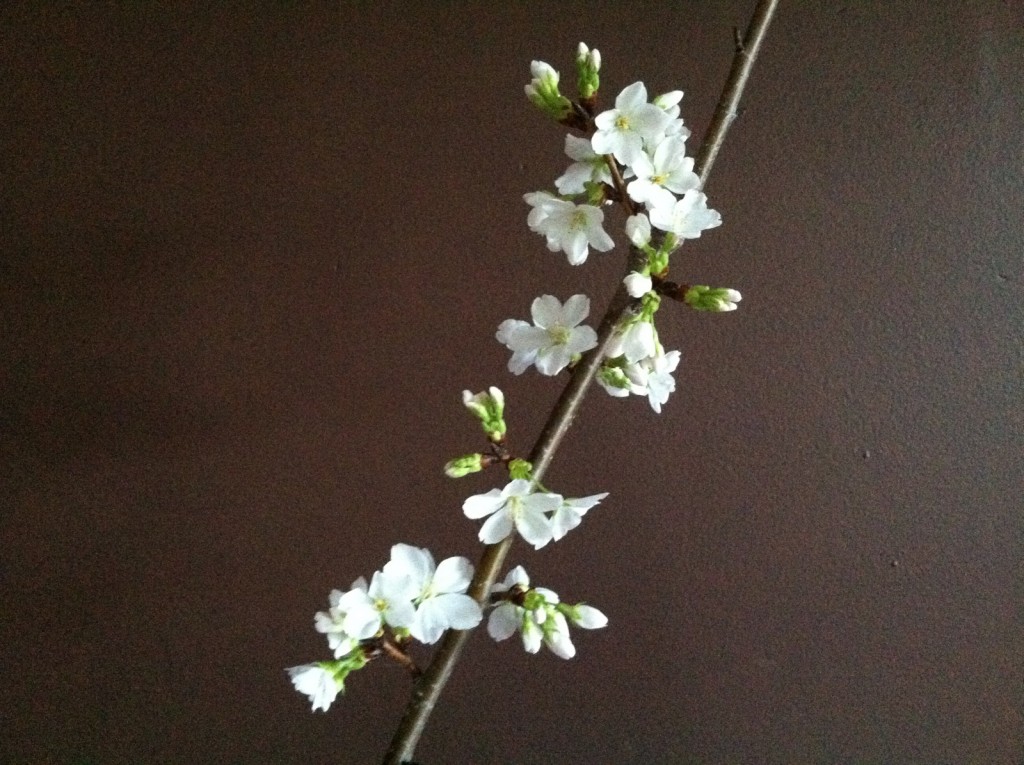
At this time of year, we’re always reminded of the benefits of having a variety of spring-blooming shrubs and trees in the garden. We’re midway through winter, and although it’s been a remarkably mild one here in the Northeast, the landscape of browns, greys, and whites has begun to prey on our spirits. To introduce a bit of vibrant natural color and beauty to our indoor rooms, and to do it economically, we force branches. You don’t need any special gear or know-how, just a pair of clean, sharp pruners and a few of the right trees and shrubs in your yard.

Among our favorites for forcing are Witch Hazel (Hamamelis), Magnolia, Forsythia, Eastern Redbud (Cercis canadensis), Shadbush (Amelanchier), flowering Quince (Chaenomeles), crabapple (Malus), flowering pear (Pyrus), flowering Cherry (Prunus), Viburnum, and Cornelian Cherry Dogwood (Cornus mas).
Sometimes starting as early as January but more likely in February and March, we make regular forays into the garden. We choose days when the temperature is above freezing, and not only for ourselves. The milder temperatures help ease the transition the plants must make from outdoors to indoors. While enjoying the fresh air in our lungs and the physical exertion of wading through snow (if there is any), we cut our branches.

The guidelines are very simple, the trees and shrubs generally very forgiving, and the results well worth the effort. Here’s how:
- Cut only branches that are nonessential to the form of your shrub or tree, or make sure you confine your cutting to the back side of the plant, if there is one, or to crowded sections where a branch or two will not be missed.
- Choose sections that are at least 1’ long and generously punctuated by plump flower buds. (In most cases, you will see leaf buds on the branches, too, but those are generally smaller and pointy at the tips.)
- Use proper pruning techniques (see Pruning Tips below).
- Bring the branches indoors and put them in a sink or sturdy vase or vessel full of warm water. (The vessel should be one that won’t tip when the weight and size of branches are added to it.)
- Some gardeners recommend re-cutting the branches or goring the stems near the cut while the branch or stem is underwater. This can facilitate uptake of water and negate the possibility of air entering the stem and sealing out the water. We confess we do this only some of the time, and the vast majority of branches blossom either way.
- Arrange your branches in the sturdy vase or vessel, and set it in a sunny spot indoors. Avoid locations atop radiators or near heat sources (although, we confess, we have broken that rule a time or two, and the buds still bloomed).
- Replace the water in your container every few days. Bacteria will flourish and impede the progress of your forcing. Severe enough bacteria has the opportunity to set rot in your forcing branches.

Generally speaking, the nearer the date is to a plant’s natural blooming time, the sooner will begin flowering indoors.

Pussy Willows can be cut in winter and brought indoors, too. Wait until the downy catkins have broken out of their casings. Cut lengths that measure at least 1’. Bring them indoors and put them in a vase with or without water. They will retain their good looks for a very long time either way.

The colors and natural beauty these branches bring to indoor spaces lift the spirits in winter. They leave no doubt that spring is on the march.

Proper Pruning Techniques
- Use a clean, sharp pruner
- Make steeply angled cuts to encourage water uptake
- Clean pruners with warm soapy water after each use

